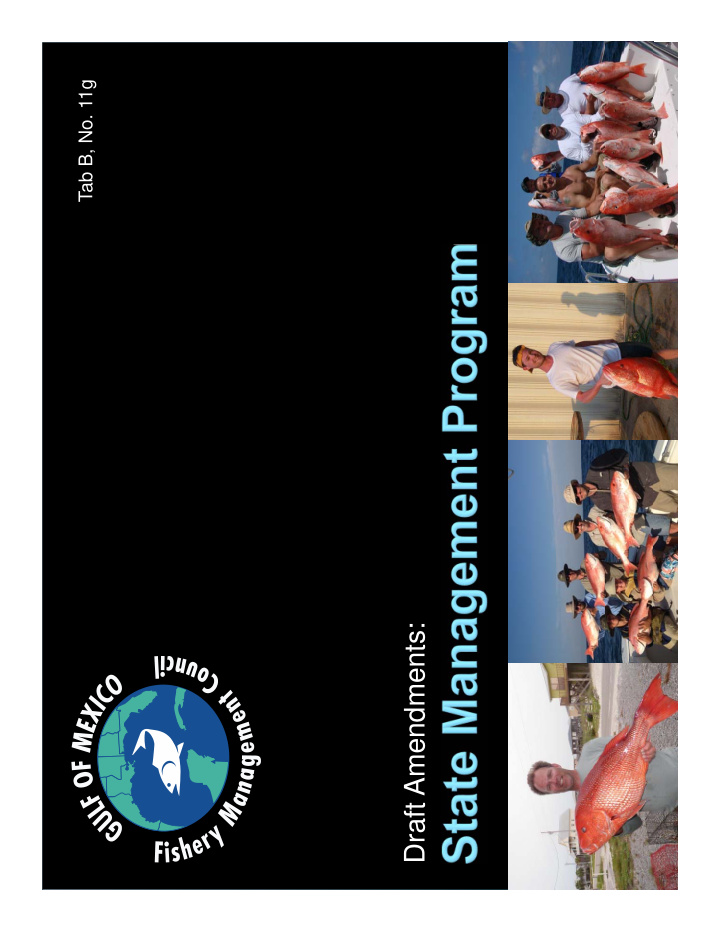



Tab B, No. 11g Draft Amendments:
• Current preferred alternatives • How state management would work Issues Potential Alternatives • Not all states • Lines marking areas participating adjacent to each state in the EEZ • Inclusion of for-hire • Endorsement to for-hire vessels permits • Options requiring on the water enforcement
Program Amendment Action 1: Alt 4 Each state decides to manage private only or both Components (Aug 2017) components. Action 2: Alt 6 EFP Allocation (June 2018) allocations Inconsistent with each other Individual States LA MS AL FL TX Action 1: Alt 2, Alt 2, Alt 2, None Alt 2, Delegation or Options Options Options Options 2a-2e CEPs 2a-2d 2a-2d 2a-2d + 2g (Apr 2018) (Apr 2018) (Apr 2018) (June 2018) Action 2: Alt 2, Alt 2, None None None Quota Adjustment Option 2a Option 2a (Aug 2017) (Jan 2018)
Action 1 – Components of the Recreational Sector to include in State Management Programs Preferred Alternative 4: For a state with an approved state management program, the state will choose whether to manage its private angling component only, or to manage both its private angling and federal for-hire components. Action 2 – Apportioning the Recreational ACL (Quota) Preferred Alternative 6: Establish an allocation of the recreational sector ACL that may be used for state management programs by apportioning the private angling ACL among the states based on the allocations set in the exempted fishing permits approved for the states to manage the recreational harvest of red snapper in 2018 and 2019.
• All 5 states have state management amendments approved and programs in place. • States establish fishing seasons when red snapper may be landed from state and federal waters. • Enforcement carried out dockside. • EEZ essentially stays open.
Not all states • participating. Inclusion of for-hire • vessels. Delegation of options • requiring on-the-water enforcement. May require partitioning the EEZ.
• Establishing allocation by state • Permits are transferable • Gulf-wide permit, but all states may not participate Alternatives: • Partition the EEZ • Endorsement to for-hire permits to determine state for landings
Alternative : Establish a red snapper endorsement for vessels with a charter/headboat permit for Gulf reef fish. To land red snapper in a state managing the federal for-hire component in the Gulf, a federally permitted vessel must have an endorsement for that state, and must follow the regulations specific to the state program for which the endorsement is issued. A Gulf-wide endorsement will be required for vessels with a charter/headboat permit for Gulf reef fish to land red snapper in a state not managing the for-hire component under an approved state management program.
If the permit is transferred and the new permit holder will be fishing in a different jurisdiction: Option a: an endorsement for a different state management program or the Gulf-wide season will not be issued to the transferred permit until the following fishing year. Option b : a new endorsement may be issued upon request for a different state management program.
State management, as it has been previously considered by the Council, included measures that would rely primarily on dockside enforcement, such as bag limits ( Options 2a and 2b ) and size limits ( Options 2c and 2d ). When in federal waters, enforcement would be of the most generous state regulation (e.g., highest bag limit) of a state with an open season. Option 2a : bag limit Option 2b : for-hire vessel captain/crew may not retain a bag limit Option 2c : minimum size limit within range of 14 to 18 inches TL Option 2d : maximum size limit Option 2e : requirements for live release devices (e.g., descending devices) Option 2f : requirements for harvest gear Option 2g : use of area or depth-specific regulations.
State regulations could Option 2e : requirements for live release be written for dockside devices (e.g., descending devices) enforcement (“must carry Option 2f : requirements for harvest aboard”), and not require gear delegation Without further information about the scope and purpose of the Option 2g : use of area or depth- area or depth-specific specific regulations. regulations, Option 2g cannot be included in a state’s delegation.
Recommend
More recommend